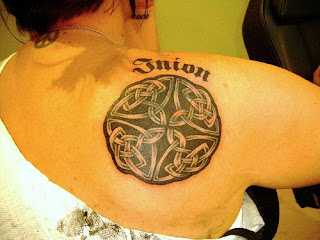
Tattoos, once the domain of bikers and other societal outlaws, have become much more acceptable to the mainstream. They can be seen on people from all walks of life, from the cigarette smoking cook at the local greasy spoon to the teen-queen suburban debutante. Tattoo ink has been applied to nearly every type of skin imaginable.
 Any reputable tattoo artist will undoubtedly have a wide range of tattoo ink available to their customers. Traditionally, tattoos were created using inks made from ash, dirt or plant material, which resulted in a very limited range of hues that could be applied. However, modern ink can be found in nearly every color of the rainbow, giving tattoo artists and customers a much wider range of options.
Any reputable tattoo artist will undoubtedly have a wide range of tattoo ink available to their customers. Traditionally, tattoos were created using inks made from ash, dirt or plant material, which resulted in a very limited range of hues that could be applied. However, modern ink can be found in nearly every color of the rainbow, giving tattoo artists and customers a much wider range of options. Brightly colored tattoo ink is arguably one of the primary reasons for the explosion in the popularity of tattoos. No longer are tattoos relegated to the style common to old sailors and convicts. A talented artist with the right training and access to the right colors can create tattoos that are more akin to fine art. A browsing through any tattoo magazine will reveal a host of beautifully created and colorfully decorated skin art. These designs can range from the most realistic depictions of flowers and butterflies to the grittiest interpretations of Dante's descriptions of hell.
Brightly colored tattoo ink is arguably one of the primary reasons for the explosion in the popularity of tattoos. No longer are tattoos relegated to the style common to old sailors and convicts. A talented artist with the right training and access to the right colors can create tattoos that are more akin to fine art. A browsing through any tattoo magazine will reveal a host of beautifully created and colorfully decorated skin art. These designs can range from the most realistic depictions of flowers and butterflies to the grittiest interpretations of Dante's descriptions of hell.
 Tattoo ink is also available in some unique hues that can be used to create a truly one of a kind tattoo. White ink, for instance, is a relatively new idea in the tattoo world. A white ink tattoo is ideal for those that want something that is unique, but not obvious. This type of ink is virtually invisible from a distance of more than a few feet, making it idea for those that do not want their tattoos to interfere with work or social circles.
Tattoo ink is also available in some unique hues that can be used to create a truly one of a kind tattoo. White ink, for instance, is a relatively new idea in the tattoo world. A white ink tattoo is ideal for those that want something that is unique, but not obvious. This type of ink is virtually invisible from a distance of more than a few feet, making it idea for those that do not want their tattoos to interfere with work or social circles.
 Black light ink is also popular for those that are looking for something unique. These inks appear to glow when introduced to black light, creating a rather stunning effect.
Black light ink is also popular for those that are looking for something unique. These inks appear to glow when introduced to black light, creating a rather stunning effect.












































